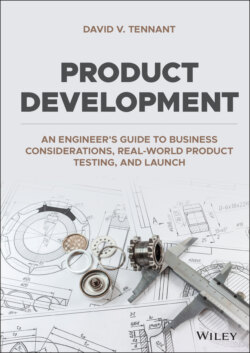Читать книгу Product Development - David V. Tennant - Страница 27
The Roles of Marketing and Engineering in Product Development
ОглавлениеSomeone from either department may serve as the project leader. However, the two groups generally have differing perspectives on priorities and timing which can lead to conflict.
Beyond the product, the marketing team is concerned with revenue, profitability, placement, and all of the previous topics discussed in this chapter. As a result, the marketing leader will be schedule-driven and concerned about containing costs. Remember, all of the costs of product development must be recaptured in the product’s pricing. Therefore, this can translate into a perception of impatience by other departments.
Engineering on the other hand, is focused on designing, testing, and delivering a product that is error free (a definition of “quality” by the way). By training and education, technical professionals have a tendency to downplay fast-tracked schedules and to a lesser extent, budget adherence. To the engineering leader, having a flawless (or “perfect”) design and manufacturing process is more important.
Consequently, the groups have differing perspectives and accountabilities, but are charged with coordinating their efforts to deliver a new product. Table 2.5 shows these differing priorities.
Table 2.5 Marketing vs. Engineering Focus in New Product Development.
| Marketing | Engineering |
|---|---|
| Cost conscious in meeting budgets, ROI (Return on investment)Schedule compressionDeveloping advertising campaignFreezing designChanges saved for next release (V2.0)Anxious to beat competitors to market (first to market gets market share) | Desire to do it right the first timeChanges to improve product are necessary for successSchedule slips are acceptable with justificationBudget is important, but having a quality product is more importantTesting and Quality Control are paramountScope changes are part of the process |
Table developed by David Tennant
Regardless of which team is leading the development effort, a certain amount of tension can be beneficial in forward progress. There will always be “give and take” in the design process. Figure 2.6, Product Development Process Flow, shows a sample process flow in the development of new products. This can vary between companies, but it provides a general sense that the development of new products is not a random series of actions, but rather, has well-defined steps with checks and balances along the way.
Figure 2.6 PD Process Flow. Credits: Diagram by David Tennant
The role of the product manager is to provide leadership to the project. This includes:
Ensuring the team has the tools, training, and support needed to be successful
Resolving conflict and building team morale
Coordinating the efforts of various departments working on the project
Serving as a conduit of information between groups
Serving as a direct link between the project team, executive leadership and external suppliers
Ensuring trust and a good working relationship between team members
Being cognizant of project quality, budgets and schedules
Ensuring all stakeholders are identified and key stakeholders are kept informed.
A product manager must be an active project participant and cannot ignore conflict, warning signs of failure, or the desires of key stakeholders. The role, whether from engineering or marketing (or any other department), is focused on managerial and leadership skills more than technical skills.
